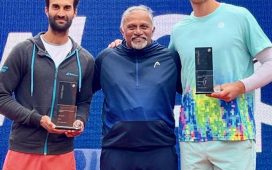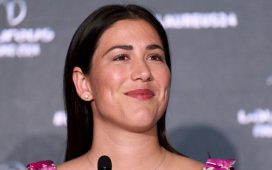The first day Sascha Bajin was at the U.S.T.A. Billie Jean King National Tennis Center getting ready for this year’s United States Open, he went into Arthur Ashe Stadium and took a quick look around.
He could still feel the atmosphere from a year ago, he said Friday.
It’s been about a year since Bajin was in the Ashe Stadium stands watching the player he coached, Naomi Osaka, win her first Grand Slam title against Serena Williams, whom Bajin used to work for as a hitting partner. It’s been about a year since the coach in Williams’s box, Patrick Mouratoglou, was caught using an illegal hand signal, which sent the match spiraling into chaos.
Williams and Mouratoglou returned to New York still a team, but Osaka and Bajin arrived separately after Osaka fired him in February.
Even in women’s tennis, where coaches are often dropped, swapped and scooped up rapidly, the sudden split stunned many. It came on the heels of Osaka’s wins at the U.S. Open and the Australian Open, her ascension to the No. 1 ranking, and Bajin’s winning the WTA’s Coach of the Year Award. There was little external sign of trouble.
Neither side has revealed the reason for the breakup. When the top-seeded Osaka begins her title defense Tuesday against Anna Blinkova, the coach in her box will be Jermaine Jenkins, a former hitting partner of Venus Williams. Bajin is in New York with 53rd-ranked Kristina Mladenovic, who is No. 2 in doubles but in singles has had considerable highs (a top-10 ranking) and lows (a 15-match losing streak).
Osaka’s results with Jenkins have not been as strong as those under Bajin, whom she hired in the lead-up to her breakthrough 2018 season. She has not reached the final of any tournament since the change and lost in the first week of the French Open and Wimbledon.
After her first-round defeat at the All England Club, Osaka tersely rejected a suggestion that the dip in her results could be connected to Bajin’s departure.
“I don’t think it’s related at all,” she said during a tearful news conference.
Though Osaka was able to back up her first major title with a second a few months later, several new young Grand Slam champions, including Sloane Stephens and Jelena Ostapenko, also struggled with expectations and consistency after quick ascents on the women’s tour.
Osaka seemed to reset for the summer hardcourt season. On social media in late July, she declared herself “excited what the future looks like on and off the court” after the “worst months of my life.” She acknowledged that she had been putting too much weight on the results of her matches.
That weight appeared to be lifted in August. Osaka was smiling frequently during matches, conscious of not taking her opportunities for granted.
“Especially, like, the Wimbledon match I played — for me, that was very rough,” she said this month. “Because normally I love Grand Slams. I love playing on the big courts. But for some reason when I was there, I wasn’t, like, enjoying it at all. Like, I was playing my match on, you know, the Centre Court in Wimbledon, and honestly, I would have rather been anywhere else.
“So I was just thinking about that and thinking about all the opportunities that I was given and how I’m kind of ungrateful for it. Like, when I lost in the first round, I was just, like, I need to start having fun, because, you know, you train your whole life for moments like that, and if you’re not happy in those moments, then there’s no point.”
Playing more buoyantly, she reached the quarterfinals in Toronto, losing to Serena Williams — “It felt like I haven’t fully leveled up my character, and I’m playing against a boss,” said Osaka, a gamer. She also advanced to the quarterfinals in Cincinnati before halting her match against Sofia Kenin because a left knee injury.
Osaka’s training has been limited in her preparation for the U.S. Open, but she expressed optimism on Friday.
“It’s getting better,” she said of her knee. “I have been playing more, longer, every day. It’s feeling better. Luckily I’m a fast healer, so I think it’s looking good.”
Bajin, who had never had a head coaching job before Osaka hired him, expressed a continuing admiration for his former player.
“I still really hope that she does really well here,” said Bajin, who has coached Mladenovic since April. “She deserves it. She’s a good girl, and an even better player. Definitely I’m rooting for her — if not for us.”
Bajin’s connection to Osaka is not completely severed. He remains sponsored by two of Osaka’s Japanese sponsors, Nissin and Yonex, whose logos he wears on his shirts at tournaments. And to further capitalize on his association with Osaka, Bajin published a book, available only in Japanese, that featured a photo of him and Osaka on the cover. The word “Naomi” appears 464 times in the book, which came out in June, four months after his firing.
But Bajin insisted the book is “not about her.”
“The book is about strengthening your mind and mental strength itself, and how to make your life a little bit easier by experiences I’ve lived through, that I’ve seen on the tour, and all that,” he said. “It has nothing to do with her; it has not much to do with tennis. Not really.”
At the tournament in Cincinnati this month, Osaka’s eyes widened at a question about Bajin’s book.
“I haven’t read it,” she said. “Don’t plan on reading it.”








